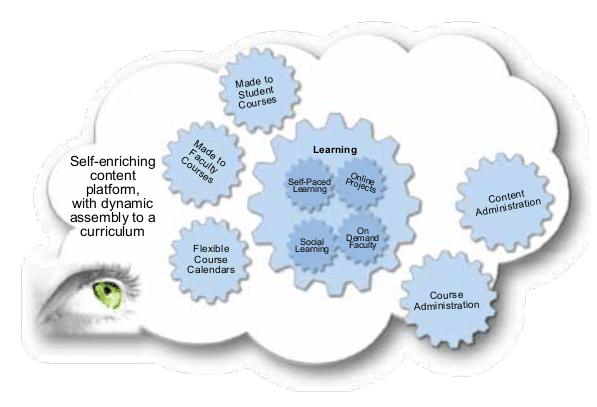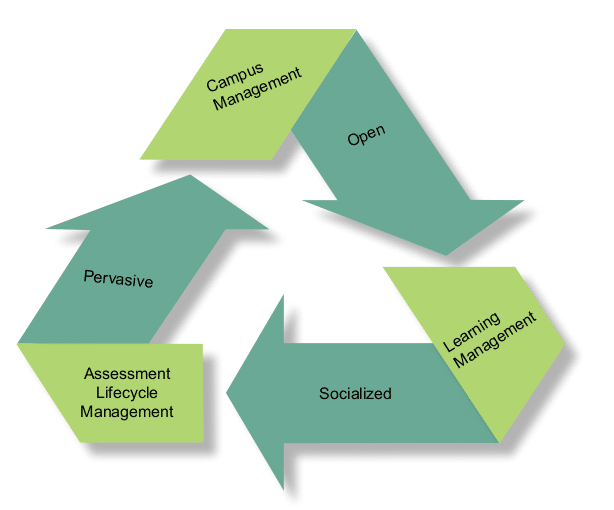 Venguswamy Ramaswamy, Global Head, TCS iON
Venguswamy Ramaswamy, Global Head, TCS iON
Smartphones have been in the mainstream for three years. And, according to a global study, 40 percent of the college students carry smartphones today. The number may be a little less in India, considering its demographics, but it is sure to rise. Students are habitually using social media and carry online connections in their pockets. Tweeting and micro-blogging have become a common lifestyle.
For education institutes, this becomes a new channel of communication with students – not to say a different methodology altogether in teaching. No longer would courses be like the classroom “broadcasts” as we have seen in our times. Institutions would leverage the new channels to render courses on demand to the students, and enriched by community. The fine line that ironically existed between teachers and practitioners would get blurred in the new connected classroom, where students and industry experts collaborate.
Classical education would remain a relic if it does not change soon. To understand how far-reaching the changes are, let me pick five trends and trace their impact on education.
The Spell of Facebook
Facebook is a dominant social medium today. Its popularity and vast membership has prevented other social net- works from being the media of common choice. The medium is a monopoly in the social media class called folksonomy, where friends and folks share messages and events. The failure of some of the other social networks that sprung up in recent times tells an important lesson – Facebook would continue to be the dominant medium as it has crossed the threshold of ubiquitous member- ship. If any other social media has to survive, it has to find a niche. It hap- pens in any form of monopolistic com- petition. Twitter found niche in being a fanfare broadcasting channel; Linkedin chose to be a purely professional net- work. Others have struggled to find a niche. Soon, there would be bridges connecting many niche networks to compete with Facebook. This lesson has deep implications in the adoption of social media in education.
For an education institute to form a social network through its students and teachers, it has two choices: either carve a social site within Facebook (which provides many options to do that), or build a network by itself and bridge it with Facebook and other networks to gather mass. By ‘mass’, I mean memberships by experts, alumni, and knowledge communities that already exist. These are crucial to the success and growth of any social media. Else, why would a student or a teacher tweet on a confined social network when he finds the other person more active on Facebook or Linked in? One has to follow the ethnology of social media to use it effectively.
At the same time, the openness of Facebook could be botheration when it is susceptible to the violations of content copyright laws. The social network by an institution would require some moderation to avoid misuse or abuse. Considering this, the choice of a privately held social network seems more prudent.
I advise that every university should not only build its own social network, but also bridge it with public networks like Facebook and Linkedin. It may em- ploy a policy regime over the bridge to govern the exchange. Today, there are technology and standards to do so. The online campus, therefore, knows no boundary. A student can rope in an expert from a public community and find like-minded people in his subject of study. Education then becomes more of a function of curiosity and less of any injected curriculum.
LMS—Now a Learning Moderation System
Even before the advent of social network channels, educational content could be digitised into online content. There are well-accepted standards, Sharable Con- tent Object Reference Model (SCORM) being the foremost, which allows multiple publishers to render content into software used by the campus. The soft- ware is usually called Learning Management Systems or LMS. With it, the faculty can publish curriculum to different batches and reading content within those. An advanced LMS also allows on demand prep test and scheduled examination, which could be assessed online. A feedback too, could be made online for the student to know how he can improve on specific subjects.
Although this sounds exciting to institutes yet to adopt technology, this method of teaching has become obsolete. LMS is now embracing many of the social media concepts and Web2.0 features. This changes the whole method of learning.
One change is in how the course content is rendered. Class notes can now become online in blogs with many students tweeting over it. Debates and refutes are exchanged regularly, which in turn are moderated by teachers, and sometimes by experts outside the campus. Research can be produced and enriched online like on wiki, and can be put to test by different disciples commenting on it. It is the revival of the age old Socratic Method that would have got lost after mankind commoditised education into universities and colleges.
The nature of content in this new LMS is therefore, very different. There is no definitive source of authenticity of content (other than online plagiarism checks) but only communities who democratically debate and add credence. The nature of interaction is also different. Instead of the traditional broadcast, we now have multiple public and private channels in play to enrich the subject. The definition of curriculum changes as well. One is not taught what is scheduled but what is acceptable to his curious mind. Any statutory propaganda, which is usually a part of regulated education, is moderated into favorable schools of thought.
The key question is not how much the student has learnt, but how much more he can absorb. This even questions the old methods of assessment.
Assess Before Teaching
As a consequence of the modern education system, assessment has become the main method of qualification. Whether a candidate has to be qualified for admission to a course or awarded a degree, assessment is the prime basis. The method of assessment, however, has always remained questionable. There is never ending debate on whether examinations should be objective or subjective, curriculum-bound or idea provoking, open book or by memory, and so on. Ir- respective of each side having its merits, the logistical convenience of the exam has remained the prime deciding factor. Exams scarcely got conducted to be directional to the career of the candidate, rather they have been mere attempts to be deterministic about the student’s knowledge retention, even though the matter may not be strictly so. We have to accept this reality in a world where education is not a matter of indulgence and practice, as it had been when the Greeks started it, but indeed, a matter of one making a career in a competitively hostile world.
However, with technology, we change the very purpose of assessments. Assessments would turn out to be formative – directional to the learning of the student, instead of being some kind of tollgate. Many assessments would happen even before the learning on the subject has stated, to define what should be taught. We already see this trend in the form of prep-tests. However, such services have remained in the domain of commercial publishers selling books to prepare for competitive exams. We would henceforth, see preparation tests happening in schools and universities, which would be followed up with an instructional process. We may also see curricula devised specifically for the student on the basis of his results in the formative assessment.
All this is possible due the recent developments we have seen in assessment technology.
Online Assessment Paradigm
Online assessments have been here for a while in vocational courses. However, for mass exams, like in universities, offline exams are still common. There are a few reasons for this. One is the lack of computer infrastructure. The other is the subjective nature of the exams requiring students to answer in written content instead of selecting from given choices. Also, the exams have to be conducted in a highly secured environment where questions papers are distributed simultaneously avoiding any leakage.
Today, technology allows us to overcome these challenges. Question papers can be digitised and transferred to the exam centers in a secured fashion. The transfer can be in complete control of the examiner. Exams can be taken in computer labs in colleges. The answers can be compiled in minutes to produce results. Different question papers can be produced by parameterising the questions. Exams may not need intensive proctoring—each student can be given different question papers, with measurable difficulty levels. The logistics of the exams are significantly simplified.
Computerised assessments open up new vistas in the education system. Each answer sheet can be digitally processed to pin point areas of improvement. It can detect psychometric patterns to determine the candidate’s behavior during the exam. It can produce reports to improve the candidate both academically and behaviorally.Class exams can be conducted more frequently and made candidate-specific. Each student can have his own education agenda depending on his learning capacity, where classes and exams are taken in tandem with regulated topics and difficulty levels.
We see that the education is becoming more personalised. Each student, with his learning pattern and personality, can follow his own pace of learning. This can be facilitated more closely by using a student information system, which combines his courses and exam records. Such information system may include important stakeholders like mentors, teachers and parents, each providing necessary guidance and supervision. The student pulls knowledge, while the rest facilitate and spur his learning. We are moving into another paradigm that we may call ‘student self-service’.
Student self-service
I generalise that at the initial age, student learning is driven by curiosity and later by a mission. In each of the states of mind, the role of parenting and teaching is subtly different. A child requires provocations to spur creativity, which in turn, would drive his curiosity. For an adolescent, a sense of mission and discipline is fenced by proper values. The values come from society, family, and institution. The job of teaching is then that of regulation and facilitation. As long as a mission is instilled in the student, he can be left on his own to pace his learning, of course within the framework of regulation.
Learning technologies sensitive to student-driven learning on different frameworks of regulation are evolving. It has already influenced campus management practices. Campus ERP is turning into systems where student avail services by themselves. The services are governed by policies set by the campus. For example, a student can opt for an optional course online, pay the fees in installments, book a room in the hostel, subscribe to books in library, and even choose his food menu from the cafeteria – all online. On the academics side, he or his parents can make an appointment with the teacher or even schedule his exams based on his preparation. Here, we are looking at a campus which is managed by policies, and students are empowered to plan their learning and time without the physical intervention of any administrative staff.
Campus 2013 and beyond
We first saw that the campus today is not confined to any boundary. With social media and Web 2.0, much of the student learning and networking happens online. Campuses need to embrace this reality. There would scarcely be a difference between campus education and distance education. Campuses should redefine their learning management system. It should run on a social media platform and not be confined to the campus. Assessment should become formative, with the only purpose to explore the student’s mind and instill what he learns best. It should be used as a method to spur a learning habit. Assessments need to be conducted frequently and may even be personalised to the student. Today, there are assessment technologies to do this scientifically. Students would be empowered to choose their path of learning but with well-designed policies. The student should feel a mission and smoothly walk his way in the campus, without the intervention of any administrative staff. The campus should define a catalogue of services, both in academics and facilities, which the student can choose in a self-service fashion. That is the campus of tomorrow. That is where we are headed, thanks to technology.






















